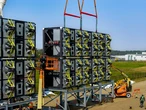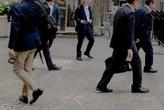To call an office merely a workplace is quite an understatement. Where we work is also where we learn, experiment, practice, grow, and connect. Especially post-pandemic, after so many of us have felt the benefits of flexible work arrangements, but may still long for in-person relationships, we expect office design to nurture our minds, bodies, and social lives.
Is it any wonder that employees are resisting the calls of CEOs for people to come back into the office full-time? Without making the office experience more appealing to workers, some CEOs expect employees to carry on as if we’re all still living in late 2019. It’s already proving to be a losing strategy.
As an architect who creates physical spaces that improve our health and well-being, I view the RTO issue as fundamentally a design problem. If we can improve office design, employees won’t just be pushed to return—they’ll feel the pull of smarter design and want to come back because they know the office is where they’re set up to do their best work.
Offices aren’t designed for people to do their best work
If the goal of an office space is to help employees function at their best, many office buildings fall short of the mark. In my experience, instead of being designed around people’s needs, office design centers around vanity and economics. Leadership tends to focus on what makes a space look good, at a low cost, rather than what helps it perform well. By focusing too much on things like company branding, impressive-looking furniture, and trendy perks like ping pong tables, there are a number of overlooked design elements that make people’s time in the office materially worse.
For instance, offices can be noisy, which has been shown to degrade performance on tasks and reduce workers’ ability to focus. They also tend to be either uncomfortably warm or chilly, which leads to lower productivity. Fluorescent lighting, combined with a lack of natural light, gives people headaches and contributes to a lack of focus. A lack of fresh, circulating air creates stale, stuffy environments that make people drowsy and sicker. Restrictive layouts, combined with poor tech hookups, inhibit basic movement in the office and inconvenience workers who are already coping with a poor space.
Employees expect more. If CEOs want employees to willingly comply and return to the office, they should expect to make some changes to their office design.
Visions of a better office design
The best offices help employees perform well while also feeling good. Performing well often means engaging in both focused work—heads-down tasks in which employees can easily find concentration—and the kind of creative work that involves relaxed free association. To perform well, employees also need the requisite spaces designed for different kinds of activities: creative brainstorming, giving presentations, and holding private conversations.
So much of our time is split engaged in shallow forms of work—texting, DMing, emailing. But workers still need dedicated spaces that allow them to achieve the opposite, or what’s called “deep work.”
In a redesigned office, these spaces are built with insulated walls, floors, and ceilings, and they include partially enclosed workspaces, a library space in larger offices, and “flow enclaves” that include warmer lighting and shallow depth of field so people can stay focused on the task in front of them.
When it comes to creative work, instead of relying on a general-purpose conference room for team brainstorming, imagine having access to space that can work in-person or digitally, tools on the walls, and pace tracks that allow workers to walk in a repeated pattern and promote thinking. for organizing your thinking. Inside the room, the lights are tuned to a warmer temperature, as it’s been shown to promote more creative thinking. To enter this space, you pass through a gallery of your colleagues’ work to inspire you. Back at your workstation, there’s a dedicated scratch pad for doodling and jotting down ideas.
How much more creative would you be if the spaces in your office were specifically designed to foster creativity, rather than forcing you to cope with nothing more than a dozen identical chairs around a table?
Employees also do their best work when they’re in good health, and offices can support people’s well-being along a number of dimensions, many without heavy interventions.
For example, the presence of plant life has been shown to filter the air within an office and boost people’s moods. If there isn’t much access to natural light, employers can install full-spectrum lighting that mimics the sun’s arc throughout the day and supports healthy circadian rhythm: cooler temperatures in the morning and warmer ones in the afternoon.
To help people move and maintain proper posture, employers can beautify stairwells with changing flowers that make taking the stairs more appealing, and they can offer to install mirrors beside people’s desks so that employees can catch themselves slouching. Employers can also use microbe-trapping paint on the walls to ensure the space is as non-toxic as possible.
There are also more sizable changes that improve people’s well-being, such as building dedicated plazas for employees to relax, recharge, and reconnect with colleagues. To help neurodivergent employees, employers give thought to minimizing wide-open spaces, bright colors, and controlling for loud noises. They can also consider how welcoming their current spaces are for families. Given that many employees with young children see coming into the office as a burden on their parenting duties, employers should weigh the benefits of offering more family services, such as an on-site daycare and comfortable breastfeeding rooms for new mothers.
These kinds of amenities are life-savers for certain employees.
Better office design helps the bottom line
Some leaders may find redesigning their office unnecessary or a frivolous expense. I encourage any skeptics to ask, in good faith, why people are so resistant to coming back. I suspect it has much less to do with their willingness to do their jobs, as some leaders have suggested, and much more with realizing that the office is simply an inferior space to do their best work.
The challenge before leaders today is to value their employees’ concerns and to acknowledge that the design of the typical modern office is long overdue for a revamp. After all, the costs of labor and staffing constitute up to 90% of a business’s expenses. If leaders can help those people perform and feel better, isn’t that worth a huge improvement for the company?
In the short term, designing offices so that they maximize people’s focus, creativity, and overall engagement can lead to healthier, happier, and more productive employees. Over time, however, it turns companies into magnets for top talent—places known for producing great results that attract the best of the best. Even if a leader isn’t sold on any other benefit of smarter design, a healthier bottom line ought to speak their language.








No comments